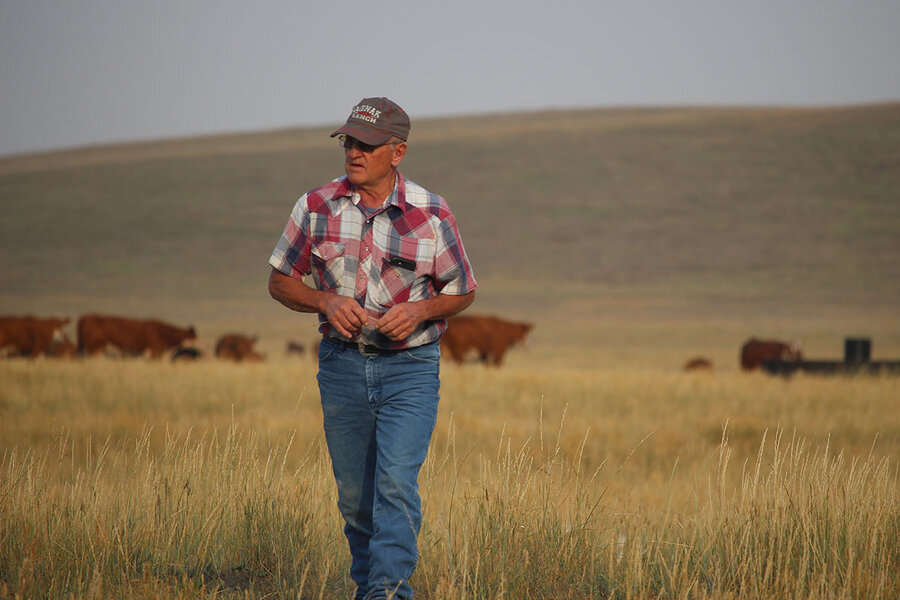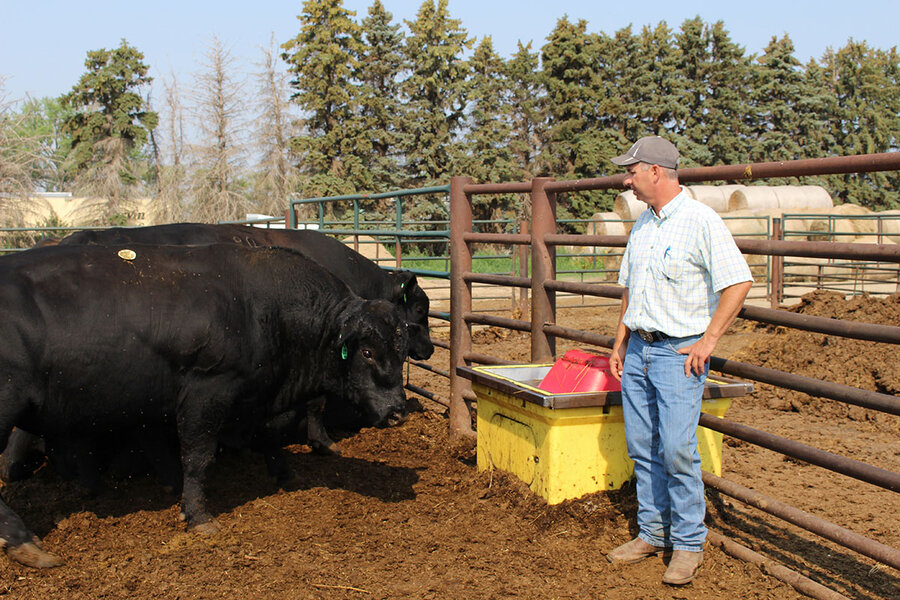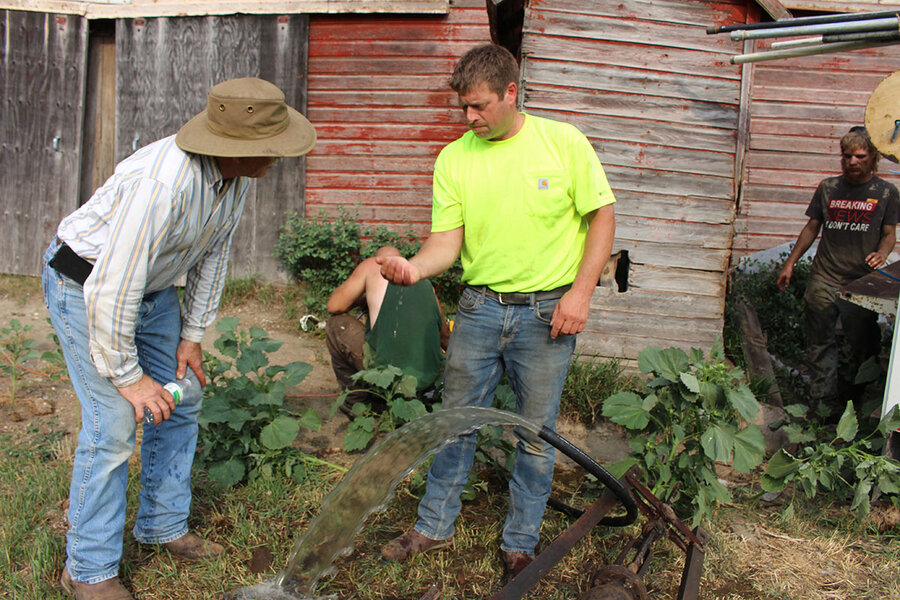To protect legacy and livelihoods, ranchers battle drought

Fourth-generation rancher Wayne Mrnak strides into a field to check the water supply for his cattle in Bowman, North Dakota, July 21, 2021. His great-grandfather homesteaded the land in 1906, and Mr. Mrnak’s children and grandchildren now live on the ranch. Photo by Doug Struck.
August 9, 2021
- By Doug Struck Correspondent
BOWMAN, N.D.
Wayne Mrnak hops out of his pickup and drops to his belly to slither under the wires of an electric cattle fence.
“Touch it, and it will bite,” he says with a grin. He dusts off and strides 100 yards into the middle of his cattle pasture. White-faced Hereford cows jog over, greeting him loudly. He quickly inspects their trough to make sure the pipeline bringing fresh water from a pump is working.
“Hundred degrees out, if these cows don’t have water, some won’t survive,” he says.
This stop is one of a half-dozen on a 60-mile loop he does every day – his “water check,” he calls it. With temperatures soaring in this dry pastureland of North Dakota – and no rain to speak of in a year – the survival of the cattle is in Mr. Mrnak’s hands.
While attention is focused on California and the Southwest, ranchers in the Great Plains are laboring to survive a drought that covers all the West and much of the Midwest.
The call of history is heavy on them. The heat and drought of the past year evoke the struggles of their ancestors; grainy old photos are reminders of the stern-faced immigrants who raised families in crude one-room log cabins, and gritted through dirt-billowing droughts and heat. They persevered. Those who followed are determined to do so, too.
Mr. Mrnak has been raising cattle in Bowman for six decades, a fourth-generation rancher. His great-grandfather homesteaded a “section” – 160 acres – here. His grandfather survived the Dust Bowl: They were down to one cow – “they fed her tumbleweeds” – and he sent his wife and two children to a relative in South Dakota because they had no food.
Mr. Mrnak recalls hearing stories from his father. His grandfather had a mental breakdown over the stress. But still they kept the ranch. That is the goal of struggles here – to keep the ranch. That is his job now.
To do that job, ranchers are paring their operations, struggling to save a few of the best animals they have spent generations breeding.
“They say history repeats itself. That’s what I’m afraid is going to happen,” says Mr. Mrnak. He is a soft-spoken man, careful with his words. But the burden of his worries are clear. The future of his ranch weighs on him “every day, of course,” he says.
Cattle raisers throughout the northern-tier states have little margin. They typically leave their cattle on the pastures to eat grass all summer and into the winter, if possible. After that, they may put out hay or silage to get the animals through winter, until the snows melt and the grass grows again.
But since June of 2020 there’s been almost no rain nor snow to keep the grass green and edible, and the heat has scorched what is there. The natural slough waterholes have dried. Mr. Mrnak worries that soon his cattle will have nothing to eat. And the hay that he and other ranchers grow to feed their cows has produced a meager yield. If he has to buy feed from another state, he could pay as much as a young cow is worth just to feed it for the winter.
Unless it “really rains, a two- or three-day soaker,” Mr. Mrnak will be faced with the prospect of selling off part of his herd.
This is a drastic move, he explains. Ranchers do not buy and sell faceless animals. They meticulously choose the parentage and gradually breed a strain that is often unique to their ranch. To slash their herd is to cut hard into that history of labor. “It’s unnerving,” Mr. Mrnak says.
Decades of work gone overnight
Three hundred miles up the road, in Rugby, North Dakota, Kyle Shively already has culled half his herd, and says he may have to sell the rest.

Cliff Mattson checks Angus bulls up for auction in Rugby, North Dakota, July 22, 2021. Ranchers have been bringing more of their cattle to Mr. Mattson for sale. His website’s home page says “pray for rain.” According to the National Integrated Drought Information System, 88% of the county is in “exceptional drought,” the highest category. Photo by Doug Struck
“For two weeks, I was depressed,” he says of the sale. “We care for our animals. I’ve had cows since I was five years old. Dad bought me my first cow and I kind of built on it. So, you know, 20 years of hard work and a lot of it’s gone, gone away overnight.”
At the Rugby Livestock Auction House, owner Cliff Mattson says some ranchers won’t even come to the sale barn to watch their livestock sold.
“They couldn’t. It was just too hard, too hard for them,” he says. “This is their livelihood.”
The sell-offs are swamping Mr. Mattson’s sale barn, where ranchers bring their cows for sale to slaughterhouses or feed lots.
“We normally sell a couple of hundred head of cows every other week,” Mr. Mattson says. “Now, we’ve had a sale every week. We’ve had runs as big as 4,000 a week.”
But Mr. Mattson takes no joy in this booming business. The downsizing leaves his community bereft of its economic engine.
“You start getting rid of the cattle, then you don’t have the calves the following year,” he says. “So our numbers are going to be way down looking into the future. We are going to get rid of at least half our herd. A lot of these smaller towns rely on the ag industry to survive. People are going to have to move away.”
Mr. Shively agrees: “I think we’re going to see in this area the cattle go to the wayside,” he says. But if he has to sell his cows, Mr. Shively says, he would try to find another rancher to work for. The pride of ranching is in all of them.
“I think everybody in the ranching world loves their job. We just don’t get paid for it.”
The ranchers say it is all up to the weather. They will trim their herds, pull in their belts, but they need some late-summer rains and a heavy snow to heal the ground.
“Yesterday I stuck my hand down a crack in the ground up to here,” Mr. Shively says, holding his arm up almost to the elbow. “That’s how bad the ground is cracking out.”
Brisk business, without celebration
This makes Ben Brase busy. He runs a well-drilling business in Rugby. Historically, in this area, cattle drank mostly from creeks or “potholes” – natural depressions filled from groundwater, rain, and melting snow. Now, ranchers are turning to wells and furiously running pipe out to troughs in their pastures, or even paying for public water to refill drinking tanks as the natural supplies dry up. They are working with an eye to the cloudless skies and a careful watch on their cows.

Ben Brase (right) discusses the water brought from a revived well with rancher Jim Fragodt in Harlow, North Dakota, July 22, 2021. Benson County is rated 99% extremely dry, a drought category in which indications include crops that stop growing and dormant pastures. Mr. Brase’s well-drilling business is based 30 miles west of Harlow. Photo by Doug Struck.
“My cows still have some water from a slough,” says Jim Fragodt, watching Mr. Brase and his workers sweat in 90-degree heat on a bluff in Harlow, 30 miles southeast of Rugby. “But it could dry up any time. You gotta have water.”
Mr. Fragodt is replacing a long-abandoned well pump next to a 100-year-old red barn, once a thriving dairy barn, now vacant and sagging. In short time, Mr. Brase and his workers, Josh Rime and Chuck Gayle, have drawn out the blackened old well jack, and installed a computer-controlled pump into the aquifer 70 feet below. A stream of fresh water erupts from a hose.
“I’m getting calls day and night,” says Mr. Brase. “We have more work every week than we can do.” He is booked out for a year, but does not celebrate. These are his neighbors, he says. He tries to respond to emergencies when ranchers suddenly run out of water. It keeps him at work into the night, missing dinners with his wife.
“It’s stressful getting calls day and night” from his neighbors, he says. “People call because they need the help. And I want to help them.”
—
To read it in the Moinitor, click her: Christian Science Monitor
